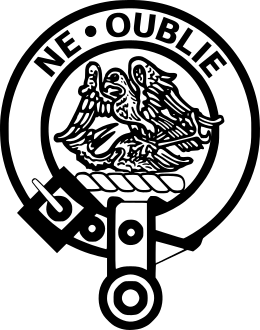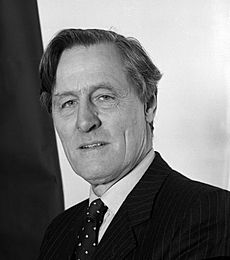Clan Graham facts for kids
Quick facts for kids Clan Graham |
|||
|---|---|---|---|
| Greumaich nan cearc (Highland Grahams only) | |||

Crest: A falcon Proper, beaked and armed Or, killing a stork Argent, Armed Gules
|
|||
| Motto | Ne oublie (Forget Not) | ||
| Profile | |||
| District | Loch Katrine, Perthshire, Dundee and Montrose | ||
| Plant badge | Laurel | ||
| Pipe music | Killiecrankie | ||
| Chief | |||
 |
|||
| The Most Noble James | |||
| The 8th Duke of Montrose (An Greumach Mòr) | |||
| Seat | Buchanan Castle | ||
| Historic seat | Mugdock Castle | ||
|
|||
|
|||
|
|||
|
|||
Clan Graham is a famous Scottish clan with lands in both the Scottish Highlands and Lowlands. Their main branch was the Montrose family. The leader of the clan eventually became a powerful noble called the Duke of Montrose. The clan's Gaelic name is Greumaich nan Cearc.
Contents
History of Clan Graham
Where the Clan Began
There's a story that the first Graham, named Greme, broke the Roman Antonine Wall. This supposedly drove the Roman soldiers out of Scotland. However, it's more likely that the Graham chiefs came from Anglo-Norman families. The name "Gregham" is even in William the Conqueror's Domesday Book.
When David I became King of Scotland, a knight named Graham was with him. Sir William de Graham was also present when Holyrood Abbey was founded. The first lands held by the Graham chiefs were near Dalkeith in Midlothian. Sir Nicholas de Graham attended a special meeting in 1290 where the Treaty of Birgham was signed.
Fighting for Scottish Independence
The Clan Graham fought bravely at the Battle of Dunbar in 1296. Sir Patrick de Graham of Kincardine was the only Scot who refused to retreat. He fought until he died, showing great courage.
Sir John de Graham was a close friend and supporter of William Wallace, a famous Scottish hero. John de Graham is celebrated for rescuing Wallace at Queensbury. He was known as Wallace's right-hand man. Sadly, John de Graham was killed in 1298 at the Battle of Falkirk, with Wallace by his side. His name lives on in the area of Grahamston. You can still see his grave in Falkirk churchyard. One of Sir John's large two-handed swords is kept at Buchanan Castle by the Duke of Montrose.
The Clan Graham also fought against the English at the Battle of Durham in 1346. They supported King David II of Scots in this fight. The Grahams gained control of lands north of Glasgow called Mugdock. They built a strong castle there around 1370.
John Stewart, in his book The Grahams, says that "Most Scottish Clans would be proud to have one great hero. The Grahams have three." He was talking about Sir John de Graham, the Marquis of Montrose, and the Viscount of Dundee. Stewart also wrote that the early Grahams were very capable and loyal people. They rose in power not by unfair means, but because of their true ability and worthiness.
15th and 16th Century Battles

The Clan Graham fought at the Battle of Sauchieburn in 1488, led by the third Lord Graham. This battle took place near Stirling, Scotland. In 1504, Lord Graham was made Earl of Montrose because of his bravery. He then led part of the Scottish army against the English at the Battle of Flodden in 1513, where he was killed. The Clan Graham also fought at the Battle of Pinkie Cleugh in 1547. In this battle, Robert, the eldest son of the second Earl, lost his life.
17th Century and the Civil War
James Graham, 1st Marquis of Montrose
One of the most famous Graham chiefs was James, the 1st Marquis of Montrose. He was a poet, but most importantly, he was a brilliant soldier for the King during the Civil War in Scotland. The Grahams joined their chief in battle. Montrose won many victories, including the Battle of Tippermuir, the Battle of Aberdeen, the Battle of Inverlochy (1645), the Battle of Auldearn, the Battle of Alford, and the Battle of Kilsyth.
After many wins, Montrose was finally defeated at the Battle of Philiphaugh in 1645 by the Covenanter army. In 1646, Montrose attacked Castle Chanonry of Ross, which was held by the Clan Mackenzie, and captured it in four days. In 1650, he captured Dunbeath Castle from the Clan Sinclair. However, Montrose was later defeated at the Battle of Carbisdale and was captured. He was then executed in Edinburgh in 1650.
John Graham, Viscount of Dundee
Another important Graham was John, Viscount of Dundee, also known as "Bonnie Dundee." By the late 1600s, the Graham family had become one of the wealthiest in Scotland.
The Viscount of Dundee led a small group of cavalry that was surprised and defeated at the Battle of Drumclog in 1679 by a much larger force of Covenanter rebels. However, he was victorious at the Battle of Bothwell Brig, where he put down a rebellion by the Covenanters. This battle was fought in Lanarkshire in 1679.
King James VII made Dundee the Commander in Chief of all Scottish Forces. Sadly, Dundee died at the Battle of Killiecrankie in 1689. He was leading the Jacobite Forces to victory against a much larger army.
18th Century and Jacobite Uprisings
The Clan Graham chose to stay neutral during the Jacobite Uprisings. This means they did not pick a side. Highlanders can thank James Graham, 3rd Duke of Montrose for helping to bring back the right to wear traditional Scottish clothing. In 1782, he convinced Parliament to remove the law that had banned wearing tartan.
Graham Castles
- Mugdock Castle was the main home of the Graham chiefs, the Dukes of Montrose. The Grahams owned it from the mid-1200s.
- Buchanan Castle in Stirlingshire is the current home of the chief of Clan Graham.
- Claypotts Castle was owned by the Grahams of Claverhouse.
- Dalkeith Palace was held by the Grahams from the 1100s. It later passed to the Clan Douglas around 1350.
- Mains Castle (also called Fintry Castle) was first owned by the Clan Stewart. It passed to the Grahams in 1350, and they built the castle we see today. The castle was later sold and is now a public park in Dundee.
- Inchtalla Castle was the home of the Grahams who were Earls of Menteith.
- Kincardine Castle, Auchterarder was a large castle owned by the Grahams from about 1250. However, it was destroyed in 1646.
- Sir John de Graham Castle, also known as Graham's Castle, is said to be the birthplace of the famous Sir John de Graham. He fought at the Battle of Stirling Bridge in 1297.
Clan Tartan
| Tartan image | Notes |
|---|---|
 |
The Graeme tartan was published in 1842. There are two main types of Graham clan tartans: the Graham of Montrose tartans and the Graham of Menteith tartans. |
Clan Chief
Since 1992, the chief of the Clan Graham has been James, Duke of Montrose. He holds several other important titles too.
See Also
- Graham (surname), for a list of famous people named Graham
- Graham, for a list of places named Graham
- Scottish clan, for a list of other Scottish clans
- The First City Regiment in Grahamstown, South Africa, wears the Graham of Montrose tartan and badge.


